Text and photos: Akul Tripathi
The strand of stories from which emerge the laments that my trip to the plateau land of the Indian peninsula brought forth, itself emerges from a rope of yore. What remains on the physical plane are the fragments which once hung on a wisp that too came undone, and off it were born legends which are their own. Legends we keep so close to our heart – that of Shivaji and his Marathas, of the Gol Gumbaz and the glittering heart of Bijapur, of Vijaynagar and its glories, of Malik Ambar and Chand Bibi. But just like the human DNA is built on that which was once all ape, these legends wouldn’t have come to pass, were it not for all who went before and achieved all that has come to pass in that geographical region we know as the Deccan.
From the unknown to the known
What once existed at this point on the third rock from the sun can best be guesses and innuendos. The most ancient lore of the Deccan is of when the earth erupted and hot magma raised it to its current form. This happened around 70 million human years ago. Over the course of the last 2000 years – about the only time that once can speak of with any authority and conviction, it was home to some of the greatest dynasties of Indian history. The Cholas, the Pandyas, the Cheras, the Pallavas, Chalukyas, Satvahanas, the Rashtrakutas, several others and their vassals ruled over this downward pointing raised triangle.
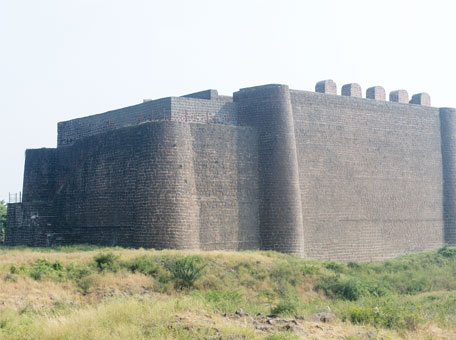
The last decade of the 13th century saw the arrival in the Deccan of Malik Kafur and his army. The Delhi Sultanate and its ways poured in with them. Only a few decades later, Daulatabad – near present day Aurangabad, became the co-capital of Muhammad Tughlaq. However, after this failed attempt at relocating and consolidating power over the subcontinent from a central position, the power of the Tughlaq dynasty in the Deccan began to wane. Taking advantage of this, Zafar Khan, the commander of Tughlaq’s army in Daulatabad declared independence, and under the title of Ala-ud-Din Bahaman Shah founded the Bahamani Empire.
The birth of Gulbarga
It was on 3rd August 1347, that in the Friday prayers at Daulatabad, Zafar Khan became the first king of the Bahamanis. The story of Zafar is as interesting as it is steeped in controversy. One version proclaims him to be the servant of a Brahmin called Gangu (Gangadhar Shastri Wabale) of Delhi, who taught him, educated him and helped him become a commander in the court of Muhammad-bin-Tughlaq. Passed on as a popular legend narrated by the 16th century poet Ferishta, the legend claims that Zafar’s original name was Hassan Gangu, and he named his line as Bahamani in memory of his Brahmin patron. While there are no official sources to confirm this slave to king legend, there are some records that claim his descent from a great king called Bahaman of Iranian lore and legend. That Zafar was of Turkic descent is quite widely accepted, however regarding the method to his becoming king – perhaps both versions have some truth in it?

The Bahamani Sultans were patrons of the Persian language and culture, and they maintained ties with the Persian court. Their patronage towards art and culture was also generous, and the reign oversaw an unprecedented blend of North Indian, South Indian and Islamic art, which matured in the coming centuries and the signs of which remain sprayed across the Deccan. The times of the Bahamanis would also come to be synonymous with the travails of the conquest of the Raichur doab – the tract of fertile land between the Krishna and the Tungabhadra River – which resulted in a series of wars with the neighbouring Vijaynagar Empire to the South. This began in the reign of Ala-ud-Din Bahaman Shah, and continued through the times of Gulbarga.
The rule of Ala-ud-Din Bahamni and later his son Muhammed Shah I, who is credited as the real maker of the Bahamani institutes, saw the blossoming on the Deccan of an unique empire in the heart of India. With powerful kingdoms in the north and south, the Bahamanis expanded east and west, and at the peak of their power, came to touch the ocean on both sides with trade ports on the Bay of Bengal and on the Arabian Sea. The kingdom was divided into four parts for administration (tarafs) and their reigns of able administration and smart warfare lay the foundation of a prosperous state.
The years were however, not without their own fair share of intrigue, which began in startling proportions at the demise of Muhammed Shah II in 1397. Muhammad Shah II had no sons and he adopted two sons – Firoz Shah and Ahmad I from his uncle Ahmad Khan, a son of Ala-ud-Din Bahaman Shah. However, later a son was born to him and on his death bed, he wished that his own biological son be made king after him. His son Tahmatan Shah succeeded him without any trouble.
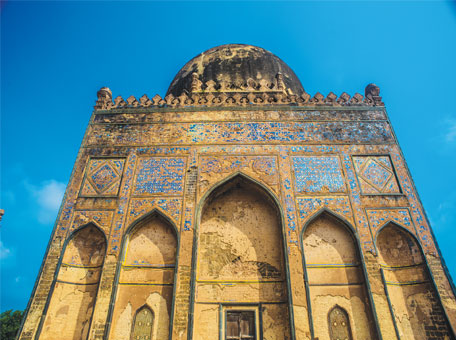
In the period of Shams-ud-Din’s reign, the intrigue continues with accounts of Tughalchin being wary of the adopted sons Firoz and Ahmad and was moving to have them imprisoned or executed. Getting wind of this, both brothers fled from Gulbarga and after marshalling resources led an attack in which Tughalchin and his son were killed and Shams-ud-Din was deposed.
The reign of Firoz was one of monumental importance to the Bahamani kingdom. It first brought a period of stability after the few months of turmoil with Tughalchin, which was done with what might have been an extremely crafty move. In 1397, Firoz ascended the throne and was having to battle neighbours who were moving to take advantage of the unsteady state of affairs in Gulbarga. In 1398, Timur (Tamerlane) had conquered Delhi. Firoz sent an embassy to Timur and secure from him a decree bestowing on him the Deccan, Gujarat, Khandesh and Malwa. While this turned the neighbours hostile, the savage destruction of Delhi by Timur and the threat of being sandwiched between Timur and Firoz might have delayed any designs of the neighbours to attack Gulbarga, giving Firoz, an unintended ruler, time to consolidate his rule. Firoz, too never made any efforts to claim these states. Bravado turned mellow or just a cheeky diplomatic move? Perhaps no one will ever really know…
Firoz himself was an extremely educated man and regarded as an intellectual of his age. He was a calligrapher and a poet, and made many grants towards arts. It was in periods of relative peace and prosperity like these that contributed to cultural advances in the Deccan. One such major advance was the emergence of a language peculiar to the Deccan, modelled after Urdu and gaining as much prominence as Persian and Arabic. This language, called Dakhani Urdu or just Dakhani, differed from north Indian Urdu in three distinct aspects. It retained more of the Punjabi that north Indian Urdu eventually lost, it absorbed much more from Sanskrit while north Indian Urdu had borrowed more extensively from Persian, and words from Persian and Arabic were modified to match local pronunciation patterns.

Now, while Ahmad had always duly and faithfully served Firoz, this prophecy alarmed him and he deposed Ahmad who escaped from Gulbarga with some of his trusted men. Gathering support with the help of a rich merchant, he returned and in battle, he cleverly defeated Firoz in 1422, who was left with no option but to abdicate in favour of his brother. The prophecy clearly manifested, but was this the intended way?
The story of the Bahamanis takes a turn from this juncture, with Ahmad shifting the capital further east from Gulbarga to the town of Bidar, where would play out the second stage of the Bahamani lament.
Gulbarga
Before whatever did come after, one must pause and realise that it is Gulbarga, which is the spout from which it all emerged. Save some odds and ends, all that remains in Gulbarga of the dynasties and rulers that came before are memories. The Gulbarga that stands on the map today, sits still on the shoulders of the Bahamanis.
When Ala-ud-Din Bahamani shifted his capital from Daulatabad to Gulbarga, the then earthen fort of Gulbarga became home to the Sultans. This fort, now an elaborate stronghold, remains the most imposing structure of the city. The stone, however, is from the 17th century, and during Bahamani times, only the gates would have been the stone features of the fort. It is within these walls that some of the earliest and most important ceremonial structures were built by the Bahamanis.
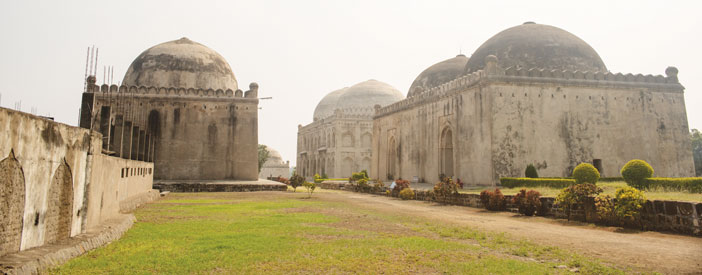
Within the fort premises, the largest building is the Jami Masjid, a congregational mosque, which was originally an audience chamber built in 1367. It has an austere appearance, and various architectural elements point to successive periods of remodelling. There is within the premises a ladies mosque as well, and a smaller mosque known as chota masjid. From here is the access to what was once the royal market street – a wide avenue lined with square chambers that is now occupied by squatters. Two unidentified buildings and several baolis (water tanks) are also situated within the fort walls.
Amongst the main remnants in Gulbarga of the Bahamanis are their tombs. To the west of the fort, hidden inside narrow bylanes of residential quarters and one lane markets are scattered the tombs of the first three Bahamani kings. Quite bereft of care, these unadorned structures of monarchs – including the founder of their house – who built the city up from black stone, lie more forgotten than the rest of the Bahamanis, who are buried together in a complex to the east of the city, known as Hafta Gumbad or Seven Tombs.

The city of Gulbarga has also the dargah of Sirajuddin Junaidi, who was the spiritual adviser to the early Bahamani kings, until his death in 1380. Near this dargah is the Shah Bazar mosque built by Firoz Shah and the Langarki or kitchen mosque, whose mihrab is the most elaborately decorated of the Bahamani period. Surrounding Gulbarga are other smaller satellite settlements of Holkonda, Firozabad and Sultanpur that contain traces of the Bahamanis.
On a hill about a kilometre away from the city of Gulbarga is a structure known as the Chor (thief) Gumbad, which is not a tomb, but considered to be a monument built by Ahmad Shah to commemorate his victory over his brother Firoz Shah. A local explanation of the name is that it was once the hideout of unsavoury elements from which it gets the name. Or perhaps it was because while designed like a tomb, it is not one and it is this trickery that earns it its name? And maybe, in having it built far from the city was Ahmad’s way of symbolically preparing for a shift of capital from Gulbarga to Bidar?
The story of Bidar
Tales of Bidar begin with the Mahabharata and it is believed to be the place where Vidur lived, and hence the place was called Vidurnagara. It is also associated with the ancient kingdom of Vidarbha. Edicts from the time of Ashoka attest to this region to be the southern part of the Mauryan Empire. Ruled successively by various dynasties, it too fell to the Delhi Sultanate, being part of Tughlaq domains. When Ala-ud-Din Bahamani Shah renegaded Tughlaq and set up his own independent kingdom, Bidar became a part of it. Also known in history as Muhammadabad, it shot to national prominence when Ahmad Shah shifted the Bahamani capital here in 1432, and remained the capital till the extinction of the Bahamanis 116 years later.
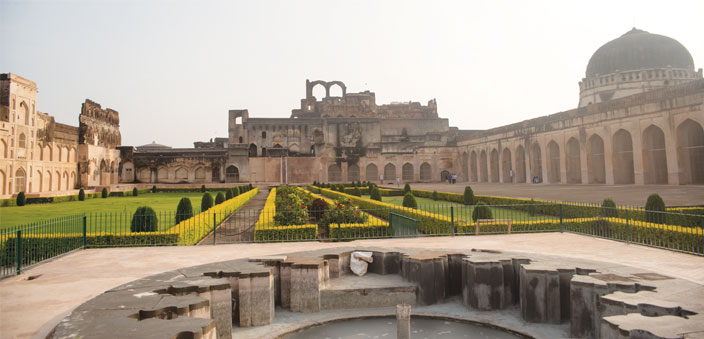
Ahmad Shah also invited from Iran the venerated Shah Nimatullah to become his spiritual guide at Bidar and possibly also to counter the might of the Gesu Daraz faction. While the Shah himself could not come, his family accepted the invitation and made Bidar and grants in the surrounding areas their home. Perhaps it is because of his close association and patronage of the sufis, that Ahmad Shah is considered a saint himself.
While the opportunity at Bidar to start something big and beautiful was bountiful, the mettle that made kings was just not the same to match those that had set up Gulbarga. However, in the reign of Ahmad Shah’s grandson Humayun, a despicably cruel maniac, fortune visited and stayed with Bidar in the guise of the learned and world renowned scholar Gawan. Gawan hailed from the village of Gawan in Persia, and had traveled to sit at the feet of one of Shah Nimatullah’s descendents. Eventually, Gawan became the prime minister of the kingdom and ably served under three rulers for over two decades.
The time of the Bahamanis with Gawan as the prime minister is essentially a tale of his achievements. After the early death of Humayun, there ascended, in short time, two minor princes and Gawan along with Humayun’s dowager queen, and another minister carried out the affairs of Bidar. Of his many achievements, the crowning glories would definitely be the capture of Goa and the port of Dabhol on the western coast from arch-enemies Vijaynagar, and the very astute administrative reform of dividing the existing four provinces into two each, making for eight smaller provinces so that no provincial overlord (tarafdar) could get too powerful. He also retained the ownership of various forts by making the governor of the forts a central government employee.
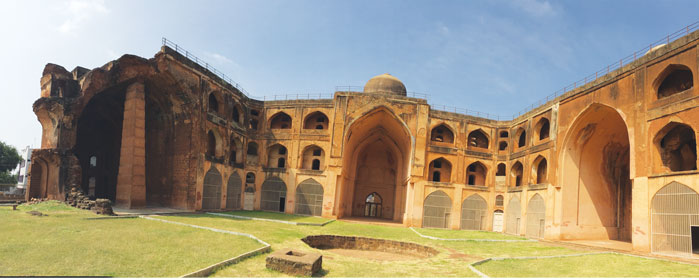
The popularity of Gawan was such that it is said that even the king Muhammad Shah III, whom Gawan was serving since the boy king ascended the throne as a minor, was jealous of his popularity. In a classical example of medieval politics and incompetent leadership, the other nobles envious of Gawan’s power forged a letter between Gawan and Vijaynagar and claimed it to be proof of Gawan’s treason. Despite his absolutely outstanding record of achievements for the Bahamanis, Muhammad Shah III ordered the execution of the 78 -year-old Gawan in 1481. Without doubt, it was the execution of Gawan that heralded the decline of the Bahamanis.
One of the many efforts of Gawan was managing the rift between the Deccanis or Mulkis (the earliest Muslims who emigrated to the Deccan), and the Afaquis or Pardesis (Muslims who came later). Immediately after Gawan’s and Sultan Muhammad’s death, in the reign of his son Mahmud, these disputes flared into civil war. At the court, power was captured by the leader of the Mulkis Hassan Nizam Shah while the leader of the Pardesis Yusuf Ali Shah retired to the taraf of Bijapur and declared his independence in 1498. In 1490, Hassan Nizam Shah was assassinated, and his son Ahmad Nizam Shah retired to Ahmadnagar and declared his independence. Taking cognisance that the independent states of Bijapur and Ahmadnagar had come to stay, Imadul Mulk, the Governor of Berar also declared his independence.
Meanwhile, the court of Bidar was the most exciting one in India at the point. A minister Qasim Barid held the king in thrall, and this Sunni minister of a Shia Sultan caused sectional differences along with the existing Deccani-Afaqui rift. Qasim Barid died in 1500, and was succeeded by his son Ali Barid, who came to be regarded as ‘the fox of the Deccan’ for his cunning. Continuing from his father, he did not allow the king to use any authority whatsoever. When Mahmud Shah died in 1518, he had been a puppet king for 36 years. Immediately after his death, the Governor of Telangana Qutb Quli Shah declared his independence at Golconda.
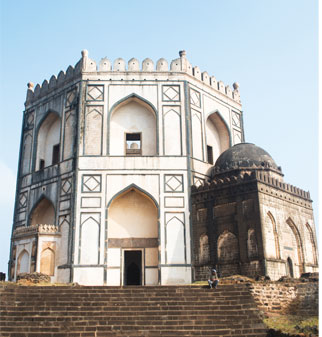
Perhaps emulating his ancestor Firoz, who sent a mission to the then conqueror of Delhi Tamerlane, Bahamani King Kalim Ullah sent a secret embassy to Babur for help in ridding the Bahamanis of Barid. Though Babur received the envoys with courtesy, he expressed his inability to come for help until he settled the affairs of north India. The existence and purpose of this mission was leaked on their arrival and fearing death, Kalim Ullah fled his kingdom, first to Bijapur where he was not welcome, and then to Ahmadnagar where he was treated with due deference and then executed a few months later. With him ended the line of the Bahamani kings. Barid declared independence, and the erstwhile Bahamani kingdom gave birth to the five Deccan Sultanates of Bijapur, Ahmadnagar, Golconda, Berar and Baridi Bidar.
The Baridis ruled a Bidar of very limited power for close to a century, bolstered through this time by the most significant event of 16th century Deccan – the defeat of Vijaynagara at the Battle of Talikota in 1565 by the combined army of the Sultanates of which the Baridis were a part.
The relics of Bidar
Like Gulabarga, the single largest relic of history is the gigantic Bidar fort with its walled moat and protection by a glacis – an artificial slope to keep assailants under fire. The construction and fortifications are more elaborate and stronger than the Gulbarga fort, primarily due to its continuing importance in history during the era of gunpowder and artillery. A large part of the fortification was undertaken by Mahmud Gawan, and then further improvements were carried out by the Baridi dynasty.
Within the walls of the fort are several palaces, audience halls, elaborate gates and other buildings of administration and storage. Some of these are very well preserved and restored admirably. Of these, the Rangini Mahal deserves special mention for the absolutely exquisite wood work, and serve as an indication of the artistic delight that the buildings of Bidar must have been at their peak.
The fort with its various zones and residences remained occupied for many years after the fall of the Bahamani kingdom. With continuing improvements and embellishments, it is now largely conjecture that determines how it would have been during the times of the Bahamanis. Near the archaeological museum is the area where horses and elephants were once stabled and also within the walled confines are extensive granaries to store rice, millet, oil and other provisions necessary to supply the fort and the city. It is in these structures that the true wealth of the kingdom lay.
The other highlight in Bidar is the madrassa of Mahmud Gawan, which besides being a testament to his statesmanship and vision, is significant due to its borrowings from the Timurid architectural traditions of Central Asia, making it unique in India. The decorations, very few of which remain, were most likely executed by immigrant craftsmen from Uzbekistan or Iran.
Bidar was a planned city of the Bahamanis and remained an important city under subsequent rulers. The various remnants from these times, mainly in the form of tombs, lie scattered all around Bidar, and its suburbs of Nimatabad, Humnabad and Kamthana. Yet, even in death and decay, it is the Bahamanis whose tombs stand tall and are handsome even 600 years after their construction, and through half a millennia of their neglect.
The Necropolis of Ashtur
To the north east of Bidar, roughly three kilometres away, lie perhaps the most surprising monuments of Karnataka – a set of mausolea, the royal necropolis of Ashtur, which has tombs of the erstwhile Bahamani sultans and their spiritual advisers, the Nimatullahs.
Chaukhandi, a four-storied building, marks the last resting place for the descendants of Shah Nimatullah and the beginning of the necropolis. From here, the eternal blessings of the saints flow outwards to bless the deceased kings who dwell in their tombs 500 metres away.
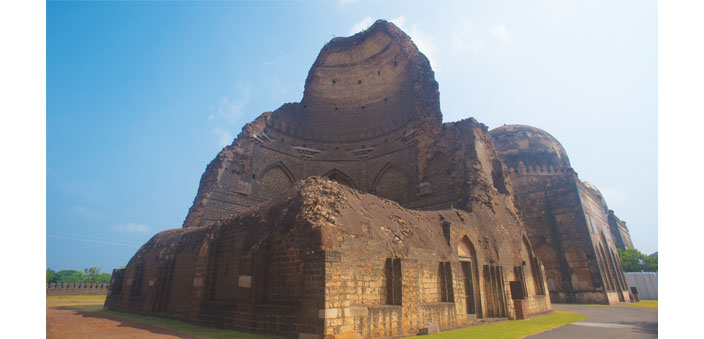
In a 200-metre stretch, are a handful of imposing tombs placed in the middle of rolling fields as if dropped in from the air like pieces in Lego land. Some broken – dramatically at that – and others complete with tantalising remains of the grandeur they must once have exhibited, the tombs of Ashtur are a mirror to the fortunes of Bidar. Grand, oversized and then steadily diminishing in size, from that of Ahmad Shah I.
Outwardly, the most striking of the tombs is the tomb of Humayun the Cruel, which seems as menacing as the Sultan is described to be. Struck open by lightning and a broken cross section, grinning malevolently even in his afterlife. Folklore says the lightning is heaven sent as a punishment for his evil ways. It is however the inside of Ahmad Shah I’s tomb that one encounters the glory the tombs were built to be.
As soon as the eye adjusts to the darkness of the tombs spacious innards, one realises one is standing inside a veritable jewel box. In what seems like technicolour when compared to the monochrome exteriors, the tomb comes ablaze with shades of gold, vermillion, cobalt, azure bring to life floral motifs, geometric designs and Quranic verses. Still venerated as a pious, saintly king, the tomb is frequented by believers on his Urs, and also colloquially known as the Ashtur dargah.
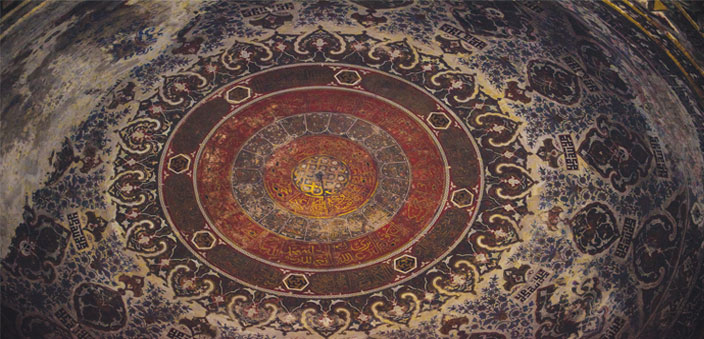
The lament of the Bahamanis
And it is in this interring of the descendent of Ala-ud-Din Bahamani that one can often meet Khaleel Shah Bahaman, who claims to be a direct descendant of Ahmad Shah, and it is in this 12th generation descendant, a wood trader and cultivator of a small patch of land with modest means, found sitting at the Ashtur dargah, that the lament of the Bahamanis is most deafening.
The lament shrieks in the windswept silence of Ashtur, but only till the time we fall for the lure of seeing it as an ending. For what on a grand scale might represent a tragedy is just the sum of many parts, which are in fact, happy stories with several joyous happenings before, during and following the milestones that are headlined as ‘Bahamanis of Gulbarga and Bidar’.
In reality, no story is ever over. On the grandest of measures, on the scale of infinity, every story begins at an-aadi (before a beginning) and ends at anant (forever). Such it is with Gubarga which was renamed Kalaburagi in 2014, but which will carry the garden of flowers within its headline for all who care to know. Through this prism of forever, India, suddenly, is no longer a lament.

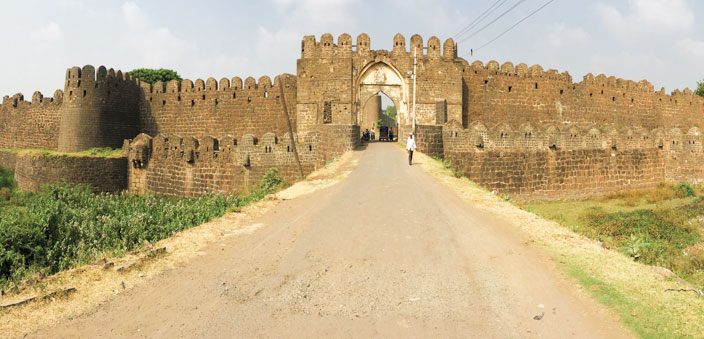
 [/column]
[/column]